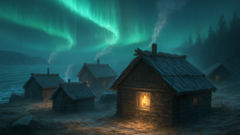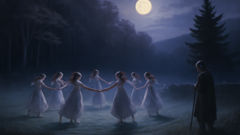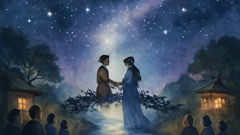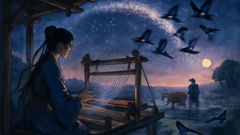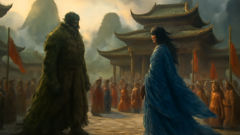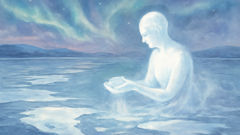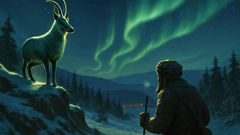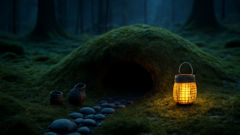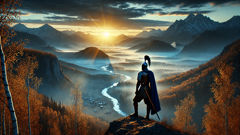Introduction
On the far edge of the world, where the Amur River meets the Sea of Okhotsk and the horizon is a thin white seam between sky and ice, the Nivkh people built their lives on the promise and the peril of fire. The landscape here keeps few secrets from the wind; it reveals hunger in the cry of gulls, it marks the rhythm of drift ice pounding the shore, it shapes the soft architecture of soot and steam that rises from the chimneys of winter houses. In those chimneys and hearths, the Nivkh say, lives a presence older than any human memory: a fire spirit that is more than heat, more than flame. They call this presence a god, though it is not distant or above them in the way of remote monarchs. It is a force that listens, responds, and remembers. It is exacting, quick to reward and quick to withdraw. In nights when the aurora shivers like great liquid curtains and the wolves travel thin as notes across the ice, families and fishing camps will speak to that warmth as if it were kin: naming it, feeding it, singing it into favor. The legend says that the Fire God holds human breath within its glow, that it is jealous yet protective, a keeper of hearth law that ties respect to survival. To the Nivkh, the rituals and stories about the fire are instructions and incantations at once—dense with practical care and luminous with moral weight. Those who forget the rules lose more than comfort; they risk hunger, the loss of catch, the bitter kindling of communal rifts that freeze faster than any river. This tale is an attempt to listen to that old voice: to trace the first flames across the ice, to record the ways kinship and ritual keep that presence generous, and to carry the warmth of a legend into a world that often forgets how to speak to fire with reverence.
Origins and the First Flames
Long before maps named these coordinates and before the first iron hooks scratched the ribs of whalebone, the Nivkh tell, there was a winter that did not end. The sea lay black as a ledger and closed over the fishing holes. The cold moved like a hand, translating hunger into bone. In that first long winter, the people were small in number and smaller in fire. They huddled in reed shelters and in the hollows of driftwood, and their stories grew like lanterns around whatever sparks they could coax from stone and bone. The origin story of the Fire God begins with a child, the tale insists, not a warrior nor a shaman, but a child with a laugh that made the cold flinch. This child, often called Koy or Koyi in older renderings—names that mean small light in different dialectal slips—was liked by animals and feared by storms. One night, when the sky bled the color of frozen tea and the people had given up hope of fish and warmth, Koy wandered to the edge of the ice, following a trail of minnows trapped in a thaw. There, among the ice ribs and stone, Koy found a feathered bird, its wing clenched in a shard of frost. The child, against a tide of fear, warmed the bird between his hands and hummed a tune known only to children and wolves. The bird opened its eyes, which shone like embers. From its chest spilled not blood but a wisp of heat, and where the wisp touched a stone the stone reddened and smoked.
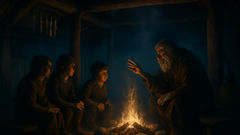
The people watched from the mouth of their huts, and by their watching the first hearth was born. But this was not a hearth that could be kept merely by gathering driftwood; it liked song and oils and the offering of stories. It liked to be named. The bird, the elders say, was a messenger of a larger being—one who walked the line between forest and flame, who could be coaxed into the world but would not be owned. The Fire God, thus introduced, is an entity of contract. It offers warmth and a nose for fish in exchange for promises kept: the naming of a fire, the feeding of ritual fat, the careful tending of ashes until they are black as the night between stars but still alive.
When the first hearth was lit in that origin winter, it did more than warm bodies; it altered the social fabric. The fire taught the Nivkh a particular economy of care. Heat became a communal resource tied to reputation and reciprocity. Families took turns feeding the hearth, and songs were layered on top of daily tasks until every action—stoking the flame, mending nets, skinning a catch—was a sentence in a conversation with the Fire God. The legends that followed were practical as much as they were holy: the cooking embers could not be covered when someone turned away; a child could never pick the last ember; a wife could not neglect to sing the morning fire awake. Transgressions, in the stories, invited a cooling that was felt in teeth and in appetite. The Fire God did not punish with fury like a storm; it withdrew, closing its fingers around warmth like a miser, letting hunger ring through the bones to teach men, women, and children what it meant to be careless.
Over generations, the legend recorded these moral economies in parable. A fisherman who stole a neighbor's embers would find his nets iced over and his breath short. A clan that forgot to name each newborn before the winter solstice would wake to smokeless night and call to no answer. But the Fire God also rewards cleverness and humility. In one celebrated tale, a woman named Arka returned from the sea with a strange ember cradled in kelp. She brought it to the communal hearth, placed it at the periphery, and, instead of claiming its heat, she let it mingle. The flame, sensing lack of greed, widened and brightened until it revealed a shoal of salmon trapped beneath thin ice—fish that no eye had seen. The community ate that season as if blessed, and they began a custom of offering the first cooked fish to the fire itself, sliding the head of the catch into the embers as if feeding a guest.
These origin stories do more than entertain; they encode a way of living with scarcity and with nature. The Fire God is at once elemental and social: a teacher of the limits of selfishness and a guarantor of communal survival when ties are honored. As the Nivkh moved across the banks and the tundra, they carried the story as a liturgy for daily life, shaping households, marriages, and disputes. The presence of the fire at the center of every home—literal and ceremonial—became a marker of identity. Elders could quiet a quarrel simply by asking whether the hearth had been tended that morning; a child's errand was not merely about wood but about learning the names of embers and the cadence of prayers whispered to them. The Fire God's origin, then, is both myth and manual: a narrative that teaches the mechanics of survival and the ethics of living under a sky that expects reciprocity.
Rituals, Respect, and the Living Fire
Understanding the legend requires learning the rituals, for the rituals are the language by which Nivkh households keep conversation with the Fire God. There are rites that map the year, rites that stitch the life stages of infants to elders, and rites that repair damage after breaches of hearth law. At the heart of these is a simple practice: naming. Every permanent fire carries a name given at its naming ceremony, usually performed at the month's turning into deep winter by a small circle of elders and the person newly responsible for the hearth. The naming is not casual. It involves the recitation of lineage—whose hands tended previous embers, who taught the specific rhythm of feeding fat to that kind of coal—and an offering: the first piece of meat from a day's catch, the first skin sewn during the season. The name is both a protection and a contract. It binds the present caretakers to those who came before and to the Fire God itself.
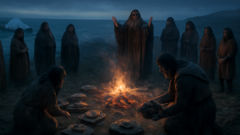
There are rules that extend from naming. Ash disposal, for example, is an art of respect. Ashes are not merely waste; they are a ledger. They hold the memory of what the fire consumed and are used to fertilize small patches of tundra where root vegetables might be coaxed. To throw ash into a stream without ritual was once believed to confuse the Fire God and the Water Spirits, a misalignment that could trap fish under unmelting ice. Similarly, the last ember of the night is never left for the taking; it is tucked into a clay pot or wrapped in a scrap of hide and carried by the eldest to the community storehouse—a place where the collective memory of warmth is kept. Those storehouse embers are pooled at the solstice to relight homes, a practical insurance policy woven into ceremonial life.
Food offerings are another axis of ritual life. When a family catches a valuable fish or seals a boar, they set aside the choicest portion to present to the fire before cooking the rest. The motion of sliding a glistening head into red coals is a precise choreography: it is meant to honor the lineage of sustenance, to remind the Fire God that humans do not take without returning. This reciprocity is mirrored in marital rites, where two families exchange embers to symbolize the joining of houses. A bride might carry a small, named ember in a pouch, a talisman against loneliness and spiritual cold. Those embers are tended together in a new home to teach cooperation. When embers are misused—stolen, hidden, or offered with insincere words—the legend says that the Fire God may choose to test the community with a night of silence. During such trials, the wise send delegations to re-plead and to relearn the proper songs and names.
Beyond domestic law there are seasonal ceremonies performed on ice and at sacred rocks where the Fire God's presence is thickest. Hunters will place tiny fires along migration paths and sing soft, repetitive refrains to call luck. Fishermen carve small wooden boats and set them with a flicker of flame as offerings at the mouth of productive rivers, believing that the Fire God will bless nets if it is called by the right name and with the right story. Shamans, when present, serve as translators between human petition and elemental temper. They do not command the fire; instead they remind it of debts and summon the ancestral ledger by reciting long family trees. When a shaman's plea and a household's honoring align, a windless night may arrive, and ice will break in forgiving sheets to reveal fish—the Fire God's way, the people would say, of repaying attentive care.
The legend is also a tool for conflict resolution. When disputes flare—over land, over a marriage, over accusations of negligence—communities will settle matters partly by evaluating hearth behavior. Did the accused tend the public flame when called? Did they share embers? Did they fail to feed the fire after a good catch? If evidence shows neglect, the community will require penance: public tending of communal fires, the hosting of a feast to which the accused supplies the labor and the first cooked fish, or a temporary relinquishment of certain fishing rights. These are not punitive only; they are restorative. The logic is that harm to the hearth harms the social organism, and the way back into favor is through service to warmth.
Stories within the Nivkh corpus also emphasize humility and cleverness as traits the Fire God prizes. Bragging is dangerous within these tales. A boastful hunter who claimed he could call the Fire God without offering anything might wake to a hearth that would not kindle from his stones. But the clever—those who could find warmth in unlikely places, who could barter a half-smile for a half-grammar of ember—found favor. The Fire God likes ingenuity because ingenuity protects the group. The legend is littered with examples: a widow who warmed her children by fashioning oil lamps from seal fat and carved bone; a fisher who learned the timing of currents by watching smoke and wind; a child who whispered the right name at the right moment and caused ice to open around a trapped seal. Each anecdote is a mnemonic: remember to be inventive, remember to share, remember to name.
In the modern era, as metal chimneys change the shape of hearths and as younger generations move to towns where gas warms apartments and supermarkets supply fish, the rituals have adapted. Some names remain as nostalgia; others survive as active law. Elders insist that even if the spark is made by a match sold in a distant market, the relationship remains the same: speak to the warmth, feed it with gratitude, and keep the ledger of ash. The legend of the Fire God thus sustains a living ethic—one that ties environmental knowledge to communal obligation. It reminds the Nivkh, and through retelling provides a lesson to outsiders, that survival in severe climates is not solitary heroism but a conversation with elements and with one another. The fire, fragile and fierce, is the mirror of human conduct. Keep it with humility and you will be kept.
These rituals—naming, offering, collective tending—are the day-to-day incantations that keep the Fire God near. They are also the stories that surface when a community seeks to teach, mend, or remember. When a child learns to carry a scrap of embers, it is because a story taught them how to move through the world with small, steady generosity. When an elder sets aside ashes to fertilize a root bed, it is because a story linked waste to future warmth. In every motion around the hearth there is a thread of belonging: a shared grammar of care that the legend of the Fire God keeps alive, season by season.
Conclusion
The legend of the Nivkh Fire God is at once a map and a mirror. It maps practical knowledge—how to coax heat from stone, how to tend coals through months of dark—and it mirrors the social architectures that make survival possible: reciprocity, humility, collective memory. In a place where winter can unmake daily life in hours, to speak to the fire is to speak to future meals, to the safety of children, to the honor of kin. The rituals preserved in story form are not relics but living practices that teach a way of being with the world: attentive, grateful, inventive. Even now, when modern conveniences change the face of hearths, the core of the legend endures: warmth is a relationship, not a right. Respect keeps the flame generous; neglect cools it to nothing. To remember the Fire God, then, is to remember a code of living—one that insists that gifts are to be returned, that names matter, and that small acts of care can tilt the brittle balance toward survival. Those who listen to the old tales and follow the patterns find, again and again, that the world is kinder to those who treat the elements with conversation and care. The Nivkh fire remains a teacher, and stories about it an inheritance—a way to pass the heat of wisdom from one generation to the next as surely as ash is carried to the soil to prime new growth.

